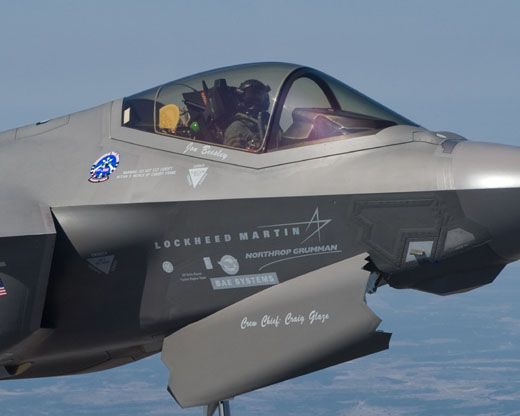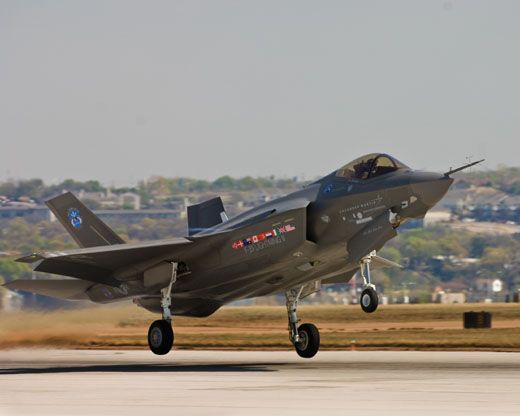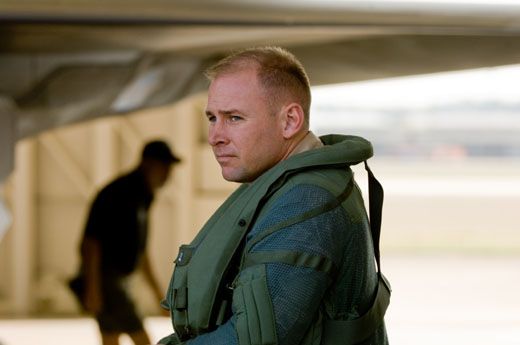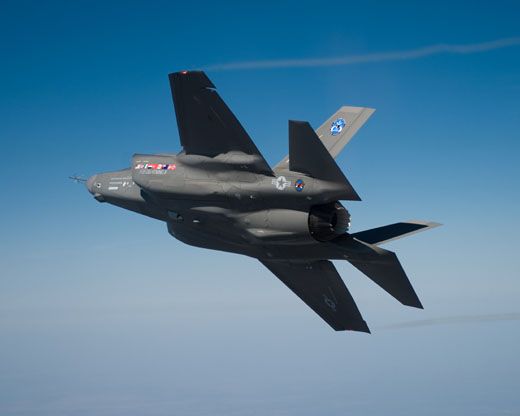Marine One
Meet J.T. Bachmann, the first USMC pilot to fly the Joint Strike Fighter.
/https://tf-cmsv2-smithsonianmag-media.s3.amazonaws.com/filer/Marine-JSF-flash.jpg)
Marine Corps test pilot Major J.T. Bachmann recently became the first U.S. Marine, the second military test pilot, and the fifth person overall, to fly the new F-35 Lightning II, or Joint Strike Fighter. Although his flight, at Lockheed Martin’s Fort Worth, Texas factory, was in the Air Force F-35A, Bachmann will begin flying the F-35B, the Marine Corps variant, with a short takeoff and vertical landing (STOVL) capability, this summer at Naval Air Station Patuxent River in Maryland. Since his 80-minute flight on March 19, Bachmann has flown the JSF one other time; he answered a few questions from Air & Space Associate Editor Mike Klesius about the experience.
Air & Space: Why did the Marine Corps have you fly the Air Force variant, rather than waiting for its own F-35B?
Bachmann: So far, with the exception of U.S. Air Force pilot Flipper Kromberg, who flew the airplane last year, the other three pilots have been corporate test pilots for Lockheed Martin and BAE Systems. They need a government pilot’s point of view. Basically, we’re the customer, the guys who are buying it. And all the models will fly similar to each other.
A&S: Do you have briefings from the corporate test pilots before flying the aircraft?
Bachmann: Definitely. I started training about two years ago. The dates slid left and right for a variety of reasons. Basically, it began with a set of specific simulator events, with a very experienced, very wise chief test pilot for Lockheed Martin named Jon Beesley. Then it was like Dad gives you the keys and takes you out and shows you the car. My first actual engine run was in December 2008. I did several engine runs, including a simple high-speed taxi test on the deck, high-speed takeoff run, a takeoff abort at 85 knots, etc. Jeff Knowles, another Lockheed Martin test pilot, and Graham Tomlinson, the BAE Systems test pilot, also trained me. Tomlinson is godfather of all things STOVL. When Graham was preparing for his June 2008 first flight in the F-35B [STOVL version], I prepared with him.
A&S: You’re an AV-8B Harrier pilot. Is the F-35 easier to fly than the Harrier?
Bachmann: Hands down, yes. And easier than other planes too. The only difficulty right now is a limited flight envelope, which is standard practice in the early stages of flight testing. Dad gave me the keys, and said I could only drive 55, and that’s it. I can’t drive it like I stole it.
A&S: What are the most aggressive maneuvers you've done in the F-35A since your first flight on March 19?
Bachmann: We’ve done basically a decent high-G turn, up to 4 G, pretty benign. Single maneuvers at 300 knots. Changing pitch, roll, or yaw, but never at the same time. Max airspeed has been 350 knots. Max altitude limit was around 20,000 feet. Then we ended up for weather and airspace going up to 18,000 feet that day.
A&S: How has flying the Harrier prepared you for the F-35A?
Bachmann: The Harrier is the most demanding airplane to fly, by far. It requires the most care and feeding. The biggest difference is that the Harrier has a center stick. The F-35 is like the F-16, with a side stick that doesn’t move much. We’re talking about fractions of an inch. A center stick pilot pulls aft, and muscle memory says, “That’s about three Gs, four Gs.” A side stick is opposite: The force with which I hold onto that stick causes the airplane to change its flight path. So it’s stick displacement versus stick force.
Another difference is that the Harrier has two levers on the throttle and your hand is always going back and forth [in hover]; the big one is the throttle, and the little one is for the nozzles, and any combination of those—and there are an infinite number—gives you the performance you want. Your left hand has to be very smart. If you’ve been to an airshow, [you may have] seen a Harrier come in at, say, 60 knots. If I want to speed up to 100 knots, I have to push the throttle forward to add power, then work the lever to change the nozzle angles, then push the control stick forward, or pull back, to get my nose up or down.
But in the F-35, the airplane does the thinking for you. If you want to go forward in hover, you just push the throttle forward and the airplane goes forward.
A&S: What else about the cockpit is different than the Harrier’s?
Bachmann: The Harrier’s cockpit, for its era, was superior. They did so much good work in that cockpit that makes it effective. It has great visibility, too. But the F-35’s is innovative, more than any other plane you’ll ever fly. It doesn’t have a lot of buttons. It’s clean and smooth. Everything is interfaced through two laptop-size screens in front of you that let you access menus and change settings. There’ll only be one screen in the end, about the size of two laptop screens joined side by side.
Not only are we developing a fifth-generation fighter, but one that’s easy to maintain. Think about when you go around to the back of a new rental car now, like I just did today. The trunk’s just an electrical switch. It’s more reliable. The F-35 will be more reliable, which means maintainers will spend less time working on the airplane and more time training for something else, or carrying a gun.
A&S: What was your very first impression as you headed down the runway in the F-35A compared to a conventional takeoff in the Harrier?
Bachmann: What you notice most is that the F-35 has a big honking engine. Big as an SUV. But in a Harrier, the engine runs a lot higher before you release the brakes, about 65 percent of military power [full power without afterburners]. So the Harrier has a very quick engine response when you slam the throttle forward to mil power. The F-35 starts at a lower throttle setting, about 30 percent of mil power, and then you slam the throttle. But the acceleration’s rapid. You look down long enough to check engine instruments, and you look up and your speed has doubled.
A&S: Will your reactions be used to make any changes?
Bachmann: Of course. Everyone wants that feedback. That’s why they want me flying the plane. They want my point of view. I’ll write actions for engineers and pilots, who hopefully will come up with changes for each and every model.
A&S: What are you looking for when you make test flights at this point?
Bachmann: Initially, we’ll talk about hover pit tests, the interaction between STOVL effectors and the jet, and make sure it’s acting as predicted. A smart engineer designed it to work properly. But that feeling might give the pilot some uneasiness. I need to present any problem to the engineers so that it gets fixed now.
A&S: What’s the trickiest or most challenging part of flying the F-35?
Bachmann: Really, it’s getting it into the air. Any test aircraft is kinda like a racehorse. Smart, but finicky. Just getting a racehorse into the starting gate and out the front can be tougher than you think. The airplane knows everything that’s going on with it. It’ll tell you what it needs. Once you get to the…runway, that’s when you say, “We’ll fly today and learn something new.”



